Karl Muller shares how Unilever achieved their ideal tax function through automation.
A CFO South Africa webinar, which was sponsored by Konsise, revealed that over 40 percent of attendees had not yet started the tax automation journey.
This dipstick information was useful, as manual tax processes have now taken centre stage as a key risk area, with SARS recently announcing that it has invested more than R3 billion in technology to clamp down on non-compliance.
Karl Muller, tax director of global projects at Unilever, explained that the multinational consumer goods company started looking at the ideal tax function about three years ago, by benchmarking itself with other multinationals.
“At the time, we were happy with the compliance systems that were running. The benchmarking exercise showed that we were middle of the range and that we could add much more value as a tax function to the business,” he said.
He added, “The reality is that every spreadsheet has at least three errors and the volume of data has grown so much so we had to change our model by leveraging technology and understanding that tax specialists should be consultants to business, delivering on an advisory role, not doing tax returns.”
Financial ecosystems
With these objectives in mind, a goal was set to be in the top quartile of companies embracing financial automation, which would be realised through a phased technology strategy.
Through this process and taking the financial ecosystems and business case elements into account, Karl was able to highlight the top three considerations for corporates. These were:
- Tax transparency: having a clear set of tax principles;
- Raising the bar in compliance: through standardisation; and
- Better use of technology: manual systems cannot cope with volume of data.
In addition, he noted additional business case elements that should receive attention, including risk management, documented and tested controls, transparency, costly errors, the benefits of a normal ROI model and better use of tax specialists.
“We looked at the processes that could be standardised, and at making better use of data lakes. This was tested on different platforms and countries. Although taxes in countries are different, the processes are pretty much the same across the globe,” he explained.
From a strategic perspective, it is expected that the payback of the investment in technology would be realised by the end of year three, with Karl confidently noting that this was on track.
“We have found a lot of value from unexpected places. In addition, you can implement lessons learnt and process improvements as you go along that leads to efficiencies in the system,” he said.
During his webinar presentation, Karl also outlined challenges experienced during the proactive financial automation journey with winning hearts and minds being at the top of the list.
“Some people are very attached to their spreadsheets and resist the change. It is important to dedicate at least one or two people to change management. The approach to digital transformation does not have to be a big bang approach, and can be phased. Then you need to figure out where to start,” he said.
Future-ready
Tertia Barrett, managing director of Konsise, explained that tax has largely remained a manual process for many businesses, even though many of them had embarked on digital transformation with sales and customer experience, among other business areas, over the past decade or so.
“Tax is not new. Most companies have monthly tax obligations and the resultant risk of manual errors. Furthermore, revenue services across the globe are investing massive amounts of money to clamp down on non-compliance,” she said.
There are therefore two key drivers driving the change to tax automation: manual systems are no longer coping with changes in tax compliance, and analytics are changing the way tax departments can add value to the business.
She also provided attendees with a demonstration of standardised automation on one system, that allowed a single status view of a number of tax indicators across businesses, including workflows that work across multiple companies. This could also then be used to drill down for detail.
Tertia highlighted three core areas to focus on for tax automation in order to create a future-ready tax office and provide early, quick wins for business.
These were:
- Process automation (preparation to submission): Covers tax workflow management, managing SARS audits and requests, storing supporting documents and notes in one place as well as management and oversight;
- Automating tax calculations (from ERP to submission): Using robotic process automation (RPA) to automate VAT 201, drill down options, manual adjustments, review and sign off and direct submission to eFiling; and
- Compliance analytics (using data analytics to check for compliance): Checking for source data, targeted VAT exceptions, shift to continuous monitoring, real-time rather than a point in time, using analytics to plan strategically, validate results and influence business decisions.
Her parting advice to attendees was to work with vendors who provide a holistic solution, that includes integration between the ERP and SARS eFiling, the right controls and future-ready technology.
“Automation is not about fixing something because it’s broken, it’s to make business future-ready by making the tax department as efficient as possible, proactively checking the quality of data internally and responding to changes nimbly as the systems are already in place,” she concluded.








